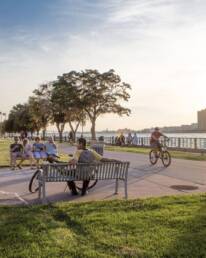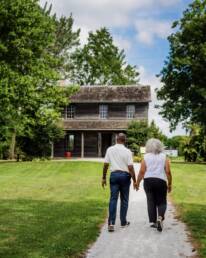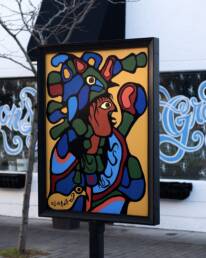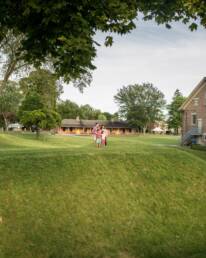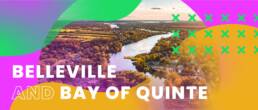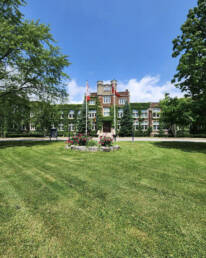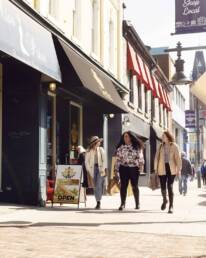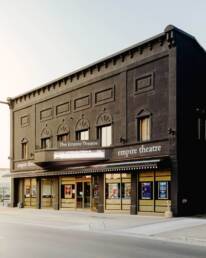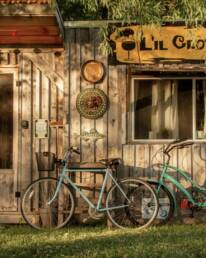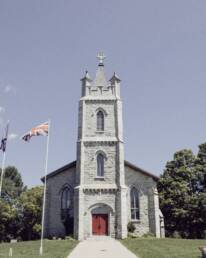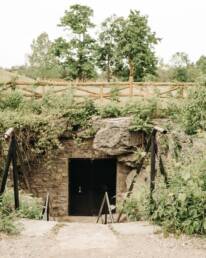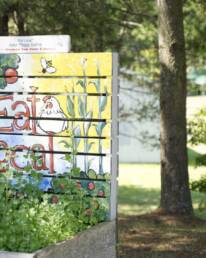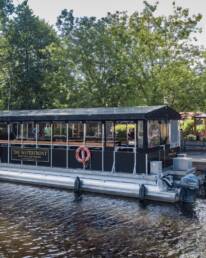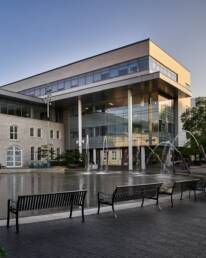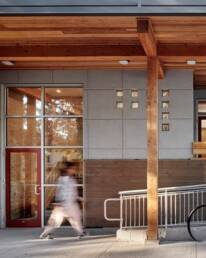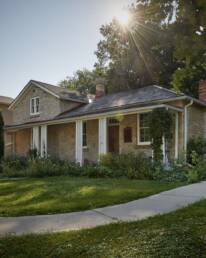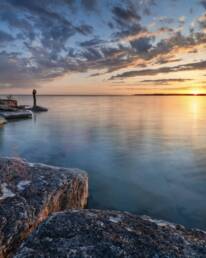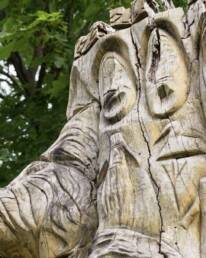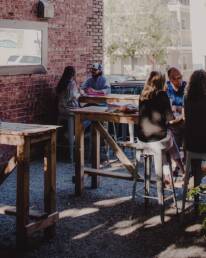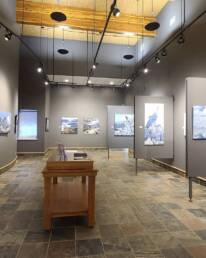Windsor, Border City
October 11, 2022 | Photo courtesy of Ontario Heritage Trust
Windsor, Border City
Stretched along the Detroit River, Windsor is a hub of cultural, industrial and creative innovation. The region is speckled with galleries, concert venues, international foods, and – as Canada’s southernmost city and a historic entry point into our nation – rich in Black history.
As a border city, Windsor played an important role in the Underground Railroad, an anti-slavery freedom movement that helped thousands to escape enslavement and start new lives in Canada where slavery had been abolished in 1834. This heritage is preserved in local museums and through annual cultural events.
Day One
MORNINGRIVERFRONT
SCENIC VIEWS AND SCULPTURE
In the morning, start your trip downtown getting to know Windsor’s riverfront, which flows past a variety of landmark experiences. The Detroit River has always been a place of convergence – before settler contact, Indigenous peoples called it Wawiiatanong, meaning ‘where the river bends.”
Whether you travel on foot or pedal along calming bike paths, you must pause to explore the Windsor Sculpture Park. This outdoor gallery holds over 33 works of public art by internationally recognized artists, including Haydn Llewellyn Davies, Sorel Etrog, and Xiaofeng Yin. With waterfront views and paved pathways, this free-entry park can be enjoyed throughout all four seasons.
AFTERNOONJOSIAH HENSON MUSEUM OF AFRICAN-CANADIAN HISTORY OR CHIMCZUK MUSEUM
RECLAIMING BLACK HISTORY
Discover Black history on a drive to the beautiful village of Dresden about 1.5 hours away. Here you can visit the Josiah Henson Museum of African-Canadian History, an Ontario Heritage Trust stewarded site. Henson was a preacher, author and, while escaping from slavery, a conductor on the Underground Railroad, rescuing 118 enslaved people in his time. Once in Upper Canada, Henson turned his passion for self-reliance and education into a new settlement, Dawn, with a school, farming community and industries. He was fictionalized as Uncle Tom in an anti-slavery novel, Uncle Tom’s Cabin. But this was an identity and name he refuted – so, the museum has recently renamed itself to reflect his objection. The sites of the Dawn settlement and its Underground Railroad stories are now told here through interactive exhibits, Black History Month programming and special events to mark Emancipation Day.
Then visit the nearby Buxton National Historic Site and Museum. Once a settlement for escaped slaves and free Black people, today the site tells the story of the Buxton community and its significance to the Underground Railroad and Black Canadian history. The museum offers guided tours, exhibits, and educational programs that help paint a picture of the community that once lived there.
Another option in Windsor’s downtown core is the Chimczuk Museum, which features a walk-through of Windsor from the pre-historic era to the modern day, including a darkened tunnel-like space which tells the stories of those who traveled the Underground Railroad.
EVENINGTHE CHRYSLER THEATRE
STAND-UP, SINGERS AND STAGE DOORS
Return downtown for an evening at the Chrysler Theatre. Situated within the St. Clair College Centre for the Arts, which boasts a competitive musical theatre program, this facility is abuzz with creative talent and offers another stunning waterfront view. There’s something for every audience, including concerts, stand-up comedy, movie nights, drag shows, and professional theatre and dance.

Day Two
MORNINGRUM RUNNERS BUS TOUR
DANCE THE CHARLESTON
Rum and whisky flowed along the Windsor-Detroit border during Prohibition in the 1920s, when spirits and alcohol were outlawed on both sides of the border. For an immersive experience, hop on the Rum Runner’s Tour bus and let a colourful, funny cast of roaring twenties characters take you back in time. Your ticket to this multi-hour tour includes lunch in a reimagined speakeasy filled with piano music of the era and boards to dance the Charleston on, if you’re feeling adventurous and up for a spin.
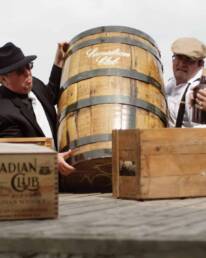
AFTERNOONART WINDSOR-ESSEX (AWE)
AFTERNOON AT THE ART GALLERY
Come back to current times with contemporary art, found at the renowned gallery Art Windsor-Essex. With nearly 4000 works of art, it is the largest public art gallery in Southwestern Ontario and includes an extensive collection of works by Indigenous artists, like Norval Morrisseau and Bonnie Devine, and artwork by Black artists Charles McGee, Kara Springer and Tim Whiten, in addition to related thematic exhibitions. You’ll also find work by a diverse array of artists at the Arts Council Windsor & Region in the Artspeak Gallery, and through their Art.Work workshops and New Voices program.
Later, you can grab a quick bite near the gallery, with The Mini Restaurant (Vietnamese), Dhesi Swaad (Indian), or Steak n Shawarma (Middle Eastern). Or for more delicious options a 5 minute drive away, try Bubi’s Awesome Eats for gourmet burgers, Native Wonders Gourmet Grub’s Indigenous inspired and traditional fare, or Mazaar with its Lebanese cuisine.
Day THREE
MORNINGSANDWICH FIRST BAPTIST CHURCH
BUILDING BLOCKS OF HISTORY
On your final day, dive deeper into Black history around the Windsor area. The first stop is Sandwich First Baptist Church. Sandwich was a town amalgamated into Windsor in 1935, but its history stands tall in this National Historic Site, the oldest – and still active – Black church in Canada. Noted for its simplicity and modest design, the church is built with bricks made of clay dug from the Detroit River. More importantly, the bricks were molded and laid by hand by Underground Railroad refugees, freemen, and runaways who settled in Sandwich. They formed a congregation which further rescued and sheltered more people escaping through the Underground Railroad, often using hidden rooms in the church to shelter newcomers from authorities.
MORNINGAMHERSTBERG FREEDOM MUSEUM AND FORT MALDEN
SITES TO THE SOUTH
Next stop is small town Amherstburg, 25 minutes south of your morning’s activities. Here you’ll find two museums: for War of 1812 history and re-enactments, go through Fort Malden; for African-Canadian history, spend the afternoon at the Amherstburg Freedom Museum.
Amherstburg was for many the last stop on the Underground Railroad; between 1800 and 1860, 50,000 men, women and children passed through or settled in this sanctuary. Those people would’ve seen the same sites preserved today by the Amherstburg Freedom Museum, like the Nazrey A.M.E. Church and the home of George Taylor, a formerly enslaved man. The museum offers guided and self-guided tours for walk-ins and tour groups, and if you come during certain seasons, you can catch cultural programming like Ribs & Ragtime and Emancipation Celebrations. Curators at the museum put together limited-run exhibits, in addition to a permanent collection of artifacts that educate and inspire.
For lunch, enjoy a picnic in nearby Centennial Park or along the banks of the Amherstburg Harbour.
AFTERNOONPOINT PELEE NATIONAL PARK
ECO EXPLORATION
For an unforgettable nature experience, take a scenic drive to Point Pelee National Park, Canada’s most ecologically diverse National Park. Birdwatching here is renowned during the migratory seasons and avid watchers can participate in the Festival of Birds, a 3-day event in May. More than wildlife, the park is also ripe for swimming, canoeing, cycling, or hiking the trails. In the fall, enjoy the annual afternoon arts market, Art at the oTENTiks, or biweekly stargazing nights. The park remains open in the winter, where you can explore quiet trails muffled by snow, surrounded by natural ice formations.
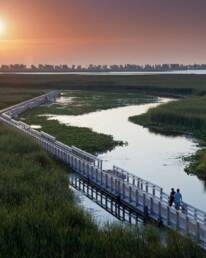
EVENINGLEAMINGTON
LOCAL EATS
Finish your day by choosing from a selection of well-regarded restaurants in Windsor including Eddy’s Mediterranean Bistro, India 47, Thai Time, or Zuleeats (which promises to take your tastebuds on a trip to Ghana with savoury pies, sausage rolls and butter tarts!).
WANT TO TAKE A DETOUR?
A BLACK MECCA IN CHATHAM
An hour away from Windsor, and run by the Chatham-Kent Black Historical Society, the Black Mecca Museum is dedicated to uncovering and celebrating the rich history of the region’s Black community. Once known as “The Forks,” Chatham was a sanctuary for runaway slaves and saw a significant increase in its Black population by the mid-1800s. Interactive displays and exhibits explore the lives of Black families who settled there.
VISIT THE ISLAND
Should you find yourself with additional time to enjoy the region, visiting Pelee Island is a must. This beautiful location houses a rare Carolinian forest, two provincial nature reserves and more than a handful of conservation areas. Wine and history buffs may want to sign up for a Pelee Island Adventures tour of Vin Villa – the most historically significant winery in North America. As part of the tour, you’ll be offered delicious tastings, and the opportunity to wander through ruins and a restored basement that will make you feel as if you’ve travelled back in time.
YOUR TRIP AT A GLANCE
SEE
Amherstburg Freedom Museum
Arts Council Windsor & Region
Art Windsor-Essex (AWE)
Black Mecca Museum
Buxton National Historic Site and Museum
The Chrysler Theatre
Josiah Henson Museum of African-Canadian History
Leamington Arts Centre
Point Pelee National Park
Rum Runners Bus Tour
Windsor Sculpture Park
NEED A MAP?
This guide represents a weekend-long experience, highlighting one of the many wonderful destinations in the area. To suggest a destination for a future guide, please contact us.
All editorial decisions were made at the sole discretion of Ontario Culture Days staff. Jacqueline Scott, Glodeane Brown, Eilish Waller and Kaitlyn Patience contributed to this culture guide.
.
Belleville and Bay of Quinte
September 9, 2022 | Photo Credit Justen Soule
Belleville and Bay of Quinte
Its official name isn’t the Beautiful Bay of Quinte but it could be — given the undeniable charms of what locals just call the Bay. As a newer travel destination, it has a very old history — back in the 12th century it was the birthplace of Tekanawita (the Peacemaker) who brought a constitution of peace to the original Five Nations Iroquois Confederacy. Today, the Bay of Quinte is fast becoming known for arts and culture (not to mention plenty of good eats).
Day One
MORNINGPRESQU’ILE PARK
FROM SHOREBIRDS TO SONGBIRDS
Birding is really taking off (pun intended!) as one of the fastest-growing hobbies in North America. Presqu’ile Park, a hot spot for bird migration with some 338 species identified, is a perfect vantage point to admire both shorebirds and songbirds. With its long sandy beach and Lake Ontario views the park is also ideal for walking, biking and camping. (The marsh boardwalk has been called “a gem” by more than one visitor.) To learn about the area’s natural and cultural history, stop in at both The Nature Centre and The Lighthouse Interpretive Centre, which highlights the park’s cultural legacy and its connection to Lake Ontario’s past.
MORNINGMEANDER ALONG THE BAY TO BELLEVILLE
FROM FLYING MACHINES TO FESTIVALS
While road tripping from Brighton to Belleville, take the opportunity to make a few stops along the way. In Trenton, visit the National Air Force Museum, which explores the country’s aviation history and features a sixteen-acre air park dedicated to flying machines (past and present). For nature enthusiasts, there is the Potter Creek Conservation Area, conveniently located off HWY 2, just as you approach Belleville
To learn about Deaf history, visit the Sir James Whitney School for the Deaf, which recently celebrated its 150-year anniversary. Explore their new Archives & Museum by booking an appointment or simply appreciate the heritage plaque on the picturesque grounds.
Another worthwhile stop is West Zwick’s Island Park on the Waterfront near the Belleville Bay Bridge, where you may often find pop-ups and festivals happening.
AFTERNOONDOWNTOWN BELLEVILLE
HISTORIC CHARM; CONTEMPORARY COOL
Sitting pretty on the Bay and the banks of the Moira, downtown Belleville is a rare find: equal parts historic charm and contemporary cool.
Pop in and out of galleries, including Belleville Art Association and Gallery 121 featuring local artists or the John M. Parrott Gallery in the Belleville Public Library. While exploring some of the many boutiques, keep your eyes open for public art too, notably local artist Chris Bennett’s colourful murals adorning a number of establishments.
A short walk (or three-minute drive) east lands you in the Old East Hill Neighbourhood. Belleville’s historic architecture provides an elegant backdrop for wandering from historic buildings like Bellevue Terrace, to Glanmore National Historic Site. The historic homes in the area date back to the 1800’s, and are the perfect setting for Belleville’s annual September Porchfest – a free, family-friendly music festival which sees thousands of attendees enjoying music played from porches, hosted by the local Rotary Club of Belleville.
EVENINGTHE EMPIRE AND MORE
DINNER, THEN A SHOW
Before enjoying a show later in the evening, make your way back to downtown Belleville to indulge in a delicious meal. If you’re craving Mexican cuisine, Chilangos is a must-visit culinary destination in Belleville. Another fantastic option in the downtown area is The Lark, a charming and modern restaurant known for its intimate ambiance and imaginative cocktails.
For a small place, Belleville sure loves its theatre – so you have a lot to choose from. There’s The Empire, a vintage 1938 theatre presenting indie films and live performances (including some of Canada’s biggest name artists). There’s River & Main Theatre Co. (at the intimate storefront Theatre in the Wings). And there’s the Belleville Theatre Guild (top notch community theatre for over seventy years). Oh, and if for some reason you’re heading back west, note that actors also tread the boards at the City of Quinte’s Old Church Theatre and the Brighton Barn Theatre.
Day Two
MORNINGTYENDINAGA MOHAWK TERRITORY
DISTINCTIVE INDIGENOUS ARTS AND CRAFTS
You’ll know you’ve arrived when you start seeing Mohawk language on street signs and buildings. Tyendinaga Mohawk Territory was established in 1784, a forced relocation leading to the loss of ancestral homelands. (Visit the Mohawk Landing on Bayshore Road to learn more.) Among the traditions of Kanienʼkehá꞉ka (Mohawk) people is distinctive original artwork and crafts. Make sure to stop at Native Renaissance, featuring emerging and well-known Indigenous artists, notably Thomas B. Maracle whose stone, wood and corn husk creations are prized internationally. Other must-stops include Rebecca Maracle’s Gallery & Gifts, showcasing exquisite feather art; Soaring Eagle Native Arts & Crafts for meticulously handcrafted work with all-natural materials, and Eagle POD Gallery, with its striking, one-of-a-kind sculptures by David R. Maracle. After this feast for the eyes, you may want a feast for the stomach: you’ll find fresh walleye at many local restaurants.
AFTERNOONHER MAJESTY’S ROYAL CHAPEL OF THE MOHAWKS
HISTORY AT THE CHAPEL
Mohawks were military allies of the British Crown during the American Revolution and part of that legacy is embodied by the chapel at Christ Church. It’s one of a small number of royal chapels outside of Great Britain and is of historic significance to both the Indigenous and colonial history of Turtle Island/Canada. The church itself, welcoming both Indigenous and non-Indigenous worshippers, was built by Mohawks and contains a triptych in the Mohawk language. Outside of Sunday services hours are variable, but it’s worth stopping by just to gaze at the 19th century Gothic revival style architecture.
AFTERNOONTYENDINAGA CAVERN AND CAVES
AN UNDERGROUND ADVENTURE
Fantastic fossils, cool depths, and a resident ghost: all of the above are found below! Meaning in the caves, which date back thousands of years. Geology lovers should get excited – the fossils found here connect sightseers to the extensive history of this natural wonder. Considered an easy and accessible adventure (at a small enough scale that even littles can enjoy), the Tyendinaga Cavern and Caves are also about ethical and sustainable tourism that gives curious visitors a chance to learn something of the local history and geology.
AFTERNOONGREATER NAPANEE ‘PALLET’ABLE ART PROJECT
ART ON THE SKIDS
As you follow the scenic route along the Bay of Quinte and up the Napanee River, you will reach the charming Town of Greater Napanee. One of the notable attractions in the town is the ‘Pallet’able Art Project, public art literally created on wooden industrial skids and pallets. Twenty-some charming original works dot the city, making splashes of bright, eye-catching colour. Navigate your way from pallet to pallet via Greater Napanee’s handy online map. (You may want to incorporate a little local history too, via the town’s historic walking tour map.)
EVENINGMUSIC
PINTS, PUBS, MUSIC
Start your evening relaxing at one of Greater Napanee’s favourite spots, for instance by having a brew at the wee patio of multiple-award-winning Napanee Beer Company. Another option, the (similarly award-winning) Waterfront River Pub and Terrace, located right on the Napanee. (Trivia note: the Napanee River is known for having its own “seiche,” a tidal effect due in part to the strong winds on Lake Ontario’s north shore.) The Waterfront often features local musicians, and for national talent check out the Starstop Concert Series, designed to catch top Canadian talent crossing the country on tour. One final music note: for concerts beneath the skies (and by the river), on a summer afternoon watch for the Music by the River series in lovely Conservation Park.
YOUR TRIP AT A GLANCE
SEE
Bay of Quinte
Belleville Art Association
Belleville Theatre Guild
Brighton Barn Theatre
Chris Bennett’s murals
City of Quinte’s Old Church Theatre
Eagle POD Gallery
The Empire
Gallery 121
Her Majesty’s Royal Chapel of the Mohawks
John M. Parrott Gallery in the Belleville Public Library
The Lighthouse Interpretive Centre
Music by the River
The National Air Force Museum of Canada
The Nature Centre
The ‘Pallet’able Art Project
Porchfest
Quinte Arts Council
River & Main Theatre Co.
Starstop Concert Series
Tyendinaga Cavern and Caves
NEED A MAP?
This guide represents a weekend-long experience, highlighting one of the many wonderful destinations in the area. To suggest a destination for a future guide, please contact us.
All editorial decisions were made at the sole discretion of Ontario Culture Days staff. This guide was written by Li Robbins.
Guelph
August 5, 2022 | Photo Credit Brandon Marsh Photography
Guelph
Guelph is famed for world-class arts festivals, its historic downtown and beautiful waterways, the Speed and Eramosa Rivers, as well as the birthplace of “In Flanders Fields” poet, John McCrae. Oh, and then there’s the beer. Seriously, the abundance of excellent craft beer has led some to declare Guelph as truly “brewtiful.”
Day One
MORNINGCIVIC MUSEUM
THE STORY OF A CITY
You can’t miss this museum — it’s located next to the stunning Basilica of Our Lady, an impressive example of High Victorian Gothic Revival style reminiscent of a medieval French cathedral. The museum itself shares Guelph stories from the era long before colonization — Guelph is built on the homelands of Anishinaabek peoples – to the city’s founding to present-day life in this diverse and vibrant community. The museum is a place to learn, and a place to play. Many a child has revelled in the The Families Gallery with its cool, interactive exhibits.
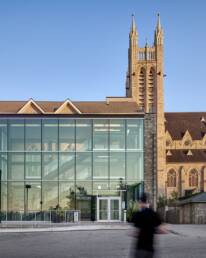
AFTERNOONMARKET SQUARE
THERE’S MAGIC IN THE SQUARE
Some city squares have a kind of magic to them, and Market Square is definitely one. Pretty in winter when ice skaters twirl, and sweet in summer when the rink turns into giant splash pad. At any time of year the historic limestone buildings make it a charming place to watch the world go by. The charm is partly by design — it’s a modern take on the original 1800s market district. Also, Market Square is home to Guelph’s impressive City Hall, live performances, and events including the annual fall Jazz Festival. Plus, there are plenty of tasty treats nearby, with downtown restaurants just steps away. (A few possible spots to choose from: Planet Bean Coffee, Eric the Baker, La Cucina, Eat Thai, and Rise and Shine Island Flavour.) Guelph, it should be noted, is serious about food! Not surprising given its agricultural roots and embrace of culinary diversity.
AFTERNOONTHE JUNCTION & SUNNY ACRES; THE WARD & ST. GEORGES
THE JUNCTION AND THE WARD
Two of Guelph’s most intriguing neighbourhoods are adjacent to downtown. To the east, it’s St. Patrick’s Ward and St. Georges (sometimes just called “The Ward”) with architecture ranging from war-time bungalows to stately Victorian homes. The Ward is also where you’ll find Guelph Little Theatre, which lives up to its slogan: a little theatre with big productions. GLT has a big history too, bringing outstanding amateur performances to theatre-goers since 1935. Next, head west to the Junction & Sunny Acres neighbourhood, the “junction” part of the name a nod to the former Guelph Junction Railway. You can see a living celebration of local railway history via “Blossom Junction,” a train made entirely of flowers. Also, don’t miss Heritage Hall nearby, current home of the Guelph Black Heritage Society. It holds a powerful history, having been built by former fugitive slaves who arrived via the Underground Railroad. Check the Heritage Society’s calendar for events that speak to that history through music, spoken word and more.
EVENINGRIVER RUN CENTRE
ARTS ON THE RIVER
The River Run is Guelph’s premiere performing arts centre, beautifully situated on the banks of the Speed River. The entrance alone is worth the visit with its copper wall a creation of Guelph artist Peter Johnston, and one that traces the history of those who’ve lived along the river from its earliest days. The centre itself opened in 1997, but a former inhabitant of the site, the Speed Skating Rink, provided entertainment of its own right. Once upon a time, orchestras played graceful waltzes as skaters circled the rink. Today, The River Run Centre is the place to go for a full range of performing arts including concerts, musicals, plays, dance and shows aimed at the whole family.
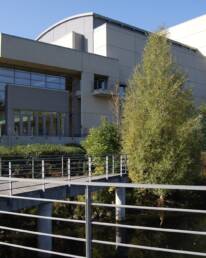
Day Two
MORNINGTHE ARBORETUM
A WORLD OF TREES
Open from dawn ‘til dusk, the outdoor Arboretum is a living classroom for University of Guelph students and faculty but it’s also a relaxing place for all to stroll. The extensive gardens, forests and trails include thematic collections like Native Trees of Ontario, centred around the conservation of the province’s native woody plants. And “World of Trees” is truly that — more than 400 species of trees and shrubs that help connect the dots between the similarities and differences of the northern hemisphere’s woody plants. There are plenty of walking trail possibilities, including The Trillium, a loop through ten plant collections, and the Mtigwaaki, designed in collaboration with Anishinaabe elders, knowledge holders and environmental scientists to share an understanding of the forest from an Anishinaabek perspective.
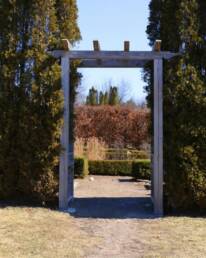
AFTERNOONART GALLERY OF GUELPH
ART IN THE GALLERY, ART IN THE GARDEN
The AGG is one of Canada’s leading galleries and sculpture parks, so naturally you’ll want to visit both. The only question is: where to start, inside or out? The Donald Forster Sculpture Park is the largest sculpture park at a public gallery in Canada, with diverse work by Canadian as well as international sculptors. Inside, there’s a strong focus on Indigenous and contemporary Canadian art, including a unique collection of Inuit drawings. Don’t miss the contemporary Canadian silver collection, the only one of its kind at a public gallery in Canada, and a top-notch showcase of the beautiful art of silversmithing.
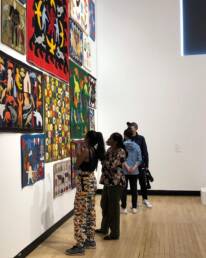
AFTERNOONMCCRAE HOUSE
“THE LARKS, STILL BRAVELY SINGING…”
In Flanders Fields, the poppies blow…There is no more famous Canadian poem from the First World War — or possibly ever! Poet, doctor, and soldier John McCrae wrote it after a young friend died in the wake of the 1915 battle at Ypres, Belgium, not knowing the incredible impact his poem would have. Red poppies came to symbolize the soldiers who died during that war — including McCrae himself. McCrae House is the stone cottage where this extraordinary man was born in 1872, and it offers visitors a chance to learn more about the man behind the poem: from family life to his many medical and military accomplishments.
AFTERNOONROYAL CITY PARK
REFLECTION BY THE RIVER
A five-minute walk from McCrae House brings you to Royal City Park, an ideal place to contemplate all that’s come before. The Sacred Fire Space located here was created by local Indigenous peoples, and is used for spiritual gatherings of prayer, gratitude, and personal healing. Walk the park’s nearly five-kilometre recreational trail to discover another way of experiencing the tranquility of the riverside.
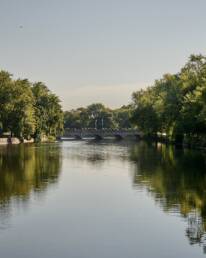
EVENINGGUELPH’S CRAFT BREWERIES
BREWTIFUL, SPIRITED GUELPH
Some around Guelph say that “beer built this town,” given the importance of early breweries to the city’s commerce. Perhaps most famous is Sleeman Breweries, which dates back to the late 19th century. Today, Guelph is famed for its craft beer, and you’ll find new favourites across the city including Brothers Brewing Company, Royal City Brewing Company, Fixed Gear, and Canada’s oldest independently owned microbrewery Wellington Brewery – all of which warmly welcome visitors. And if beer isn’t your thing, not to worry, Guelph is also home to two distilleries – Spring Mill Distillery and Dixon’s Distilled Spirits. Cheers!

YOUR TRIP AT A GLANCE
SEE
The Basilica of Our Lady Immaculate
The Civic Museum
The Royal City Families Gallery
Guelph Little Theatre
Heritage Hall
The River Run
John Galt Park/Locomotive 6167
The Arboretum
The Trillium Trail
Mtigwaaki Trail
University of Guelph
Donkey Sanctuary of Canada
Honey Bee Research Centre
Art Gallery of Guelph
Donald Forster Sculpture Park
McCrae House
Royal City Park
Guelph Jazz Festival
HISTORY AND CULTURE TO SEE
Scugog Shores Museum
Great Blue Heron Casino
Annual Mississauga First Nation Pow Wow
Ojibway Heritage Interpretive Lands
Scugog Shores Museum Village
The Dragon Boat Festival
Port Perry Fair
Port Perry Lakefront Farmers’ Market
Bird’s Eye Park
Ocala Winery & Orchard
The Thomas Foster Memorial
The Old Stone Church
YOUR TRIP AT A GLANCE
This guide represents a weekend-long experience, highlighting one of the many wonderful destinations in the area. To suggest a destination for a future guide, please contact us.
All editorial decisions were made at the sole discretion of Ontario Culture Days staff. This guide was written by Li Robbins.
Manitoulin Island
July 15, 2022 | Photographer: © Peter Baumgarten
Manitoulin Island
Welcome to the largest freshwater lake island on the planet. Odawa Mnis (a.k.a. Manitoulin Island) is known for the natural beauty found in its winding trails, views of Lake Huron and Georgian Bay and over one hundred inland lakes. As home to six First Nation communities, including the famously unceded Wiikwemkoong, as well as nearby Whitefish River and Sagamok First Nations, the Island is imbued with Indigenous history and culture.
Day One
MORNINGWIIKWEMKOONG
A PROUD HERITAGE
Wiky, as it’s known locally, is unique in being unceded Indigenous territory, meaning the rights to the land were never signed away to any nation. Guided tours are one way of learning about this proud heritage, with a range of tour possibilities depending on the day. Paddle through fishing islands along Lake Huron and gaze upon the La Chloche Mountain range on the “Bay of the Beaver Canoe” tour. “The Unceded Journey” tour takes you to historic sites to gain an understanding of the seminal 1836 and 1862 treaties, and to learn local lore and legend. Wikwemikong Tourism is your port of call to find out more and to book tours. Speaking of booking tours, you may also want to look into the possibility of a viewing at the Mishibinijima Private Art Gallery where you’ll see the stunning work of artist James Mishibinijima.

AFTERNOONBEBAMIKAWE MEMORIAL TRAIL
EXPLORING THE TRAIL
As a visitor to Wiky you’re invited to learn more about traditions of the Anishinaabek people of the Three Fires Confederacy: Ojibwe, Odawa, and Potawatomi. One way to do this is through events (notably the Annual Cultural Festival, one of the largest Pow Wows in north-eastern North America). You can also take time to walk some of the professionally built 12 kilometres of trails collectively known as the Bebamikawe Memorial Trail. Scenic lookout points provide information about Anishinaabek history and beautiful views of the North Channel and Georgian Bay. Fitness fans can lace up for the one-and-a-half kilometre (bicycle-friendly) training trail, and birders should definitely bring the binos.
Speaking of varied passions, en route to Little Current you’ll find the Rainbow Ridge Golf Course, one of many primarily Indigenous-owned businesses on the Island, located outside of the village of Manitowaning. Manitowaning is also home to critically acclaimed Debajehmujig Theatre Group, part of Debajehmujig Storytellers, a multi-disciplinary arts organization dedicated to the revitalization of the Anishnaabek culture, language and heritage. The site is open all day, and offers a gallery in addition to their theatre shows. Among their ground breaking work is 2022’s conclusion of an international trilogy that began in Mexico and Ireland — make sure to check the Debajehmujig website for any upcoming performances.
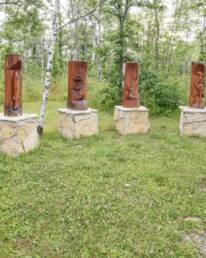
EVENINGLITTLE CURRENT
BOATS, BBQ AND BREWS
A twenty-five minute drive brings you from Manitowaning to Little Current, the island’s four-season access point via the famous swing bridge. It’s also the Island’s largest town, so yes, an excellent spot for dinner. Popular spots include Manitoulin Brewing Company and Brewgers food truck, Elliott’s (classic Canadian cuisine) and The Anchor Inn Hotel (known for its whitefish). Three Cows and A Cone is fun option for pizza and (no surprise) ice cream. An after-dinner boardwalk stroll lets you peek at boats from all over the Great Lakes, as well as some from farther afield — makes sense, given that Georgian Bay’s north channel is considered some of the best freshwater boating anywhere. For live music visit Little Current in August to hit up the annual rock and country music festivals.
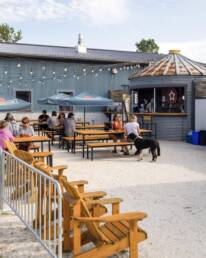
Day Two
MORNINGCUP AND SAUCER TRAIL
CUP, SAUCER AND A HIKE – MICHIGIWADINONG
One of the Island’s best known attractions is The Cup and Saucer/Michigiwadinong trail, about a twenty minute drive west of Little Current on the Manitoulin extension of the Niagara Escarpment. Michigiwadinong means “bluff in the shape of a spearhead,” a reference to it being the place where famous trickster Nanabush lay down his spearpoints while fleeing Iroquois warriors (warriors he’d tormented for generations). The legend and the surrounding area’s history makes it an iconic spot. It’s also a hiker’s delight, with twelve kilometres of trails creating multiple options from fifteen minutes to four hours. There are good reasons it’s one of Ontario’s most popular hikes — magnificent 70 meter cliffs, wonderful views of the Island’s lakes and fields, and closeups of escarpment rock.

MORNINGM’CHIGEENG
HISTORY AND HERITAGE CRAFTS
You’ll find the Ojibwe Cultural Foundation in M’Chigeeng, with its museum, art gallery, gift shop and amphitheatre. Learn about Anishinaabe spiritual knowledge, history and cultural practices at the museum, and enjoy beautiful heritage crafts including porcupine quill boxes, ash and sweetgrass baskets, and antler carvings. Crafters and artists may also enjoy this area as it is home to Lillian’s Crafts (offering items made from local materials and artwork by Indigenous artists), as well as the original source for the much lauded Beam Paints (pigments harvested from the LaCloche mountain range).
Next, lunch. Maggie’s Café offers home cooking (literally — Maggie’s recipes are passed down from “Great Grandma Agnes Roy, Maggie Roy and Betsy Debassige”). Another option, Maja’s Garden Bistro, is a short jog south of town and is known for local food and organic baking. Film buff alert: the Weengushk Film Institute (an artist-focused film and TV training centre) is based in M’Chigeeng, and collaborates with the Weengushk International Film Festival to showcase work by Indigenous and diverse filmmakers.
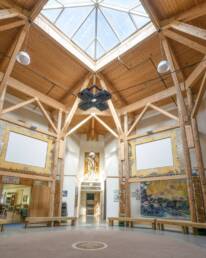
AFTERNOONKAGAWONG
“ONTARIO’S PRETTIEST VILLAGE”
Kagawong, located midway between between M’Chigeeng and Gore Bay, has been called Ontario’s prettiest village and no question it’s a picturesque waterfront town. That handsome limestone building you’ll spot is the Old Mill Heritage Centre, a former pulp mill turned art gallery and museum. Learn about the Island’s agricultural, military and shipping/fishing history, as well the tragic tale of Daniel Dodge, a scion of the automotive family of the same name. Kagawong is also home to Odemin Gallery, specializing in carving using wood, stone and bone found on the Island. Odemin is also a source for tours of the Cup and Saucer trail and the area’s most famous attraction, Bridal Veil Falls, a hidden gem of a waterfall. Swimmers come prepared. On a warm day you may want to traipse down the staircase and enjoy a dip below the falls.
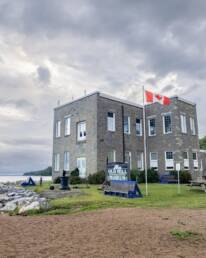
EVENINGPROVIDENCE BAY
SPECTACULAR SAND AND SUNSETS
Providence Bay is known for its spectacular sand beach — and equally spectacular sunsets. Originally called Bebekodawangog, meaning “where the beach curves around the water,” the story goes that it was settler survivors of a shipwreck who first referred to it as Providence. Shallow water makes it a family swimming destination, and it’s a draw for lake trout and salmon fishing. Gaze at Lake Huron from what’s arguably the best beach in Northern Ontario, or stroll the boardwalk, possibly with a cone in hand from Huron Island Time. For something more substantial there’s Lake Huron Fish and Chips — whitefish as always an Island delicacy. And the Mutchmor and Providence Peace Café is where you’ll find local artwork and fresh baked goods. If you’d like to get your bearings on the history and ecology of the bay, take time to visit the Discovery Centre. After all, visiting the Island is nothing if not about discovering what makes it such an intriguing destination.
Ontario Culture Days thanks Indigenous Tourism Ontario for their support and contributions to developing this itinerary
YOUR TRIP AT A GLANCE
SHOP
NEED A MAP?
This guide represents a weekend-long experience, highlighting one of the many wonderful destinations in the area. To suggest a destination for a future guide, please contact us.
All editorial decisions were made at the sole discretion of Ontario Culture Days staff. This guide was written by Li Robbins.
Thunder Bay
May 25, 2022
Thunder Bay
Stunning landscape meets unique history in Thunder Bay. On the shores of Lake Superior, the city is an amalgamation of Fort William and Port Arthur and boasts the largest Finnish population per capita outside of Finland. Clues to the earliest inhabitants — stone tools, spear points — point to a 10,000-year history. On the traditional territory of the Anishinabek, the nearby Fort William First Nation is a hub for Northwestern Ontario Indigenous communities.
Day One
MORNING
PRINCE ARTHUR’S LANDING
WALK THE WATERFRONT
Prince Arthur’s Landing is an excellent vantage point to experience this port city. Public walking paths and art displays make it a lovely spot to stroll and reflect. Visit the striking Spirit Garden, inspired in part by the vision of highly influential Anishinaabe painter Roy Thomas, incorporating Indigenous art and building techniques. The design raises the profile of Indigenous knowledge while restoring the waterfront with native vegetation.
The waterfront district is also home to many of Thunder Bay’s major events and festivals including Wake the Giant Music Festival, celebrating Indigenous culture, or the Festival of India, for arts, culture, music and food.
If your glimpse of the lake leaves you wanting more, consider booking a sail boat tour — you’ll find the craft of your choice with Sail Superior at Pier 3. Want to stay shoreward? The Alexander Henry is a museum of transportation — on a ship! Visit Goods and Co and other artisans and boutique retailers, or grab a bite in the Waterfront District.
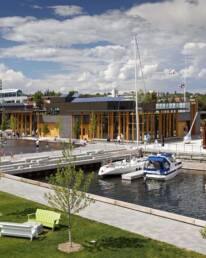
GOODS & CO.
ARTS AT THE WATERFRONT
After enjoying the waterfront view, take a short walk to Good & Co Market, also in the Waterfront District. This urban market is a hub for local artisans and boutique retailers. It’s also a growing centre for arts and culture in the city, featuring the Co.Lab Gallery space that showcases Canadian artists and hosts various community-based events and projects.
If you’re hungry for lunch, Good & Co offers a range of food options. You can create your own burrito or taco salad at PocosMas, grab some healthy treats at Superior Bakes, or savour dishes made with fresh, locally-sourced ingredients at Growing. If none of these options suit your taste, there are also numerous cafes and restaurants in the area.
While in the area don’t forget to check out the Anishinabae Art Gallery, founded by artist Roy Thomas’ widow, located just around the corner from Good & Co. Market.
AFTERNOON
BAY & ALGOMA
FINNISH FINDS
The pedestrian-friendly Bay & Algoma neighbourhood hints at Thunder Bay’s considerable Finnish and Scandinavian history with specialty shops like Finnport and The Kitchen Nook & The Finnish Bookstore. As you wander keep an eye out for other choice stops too, for instance, artist-owned-and-operated Fireweed and indie bookseller Entershine Bookshop. You’re spoiled for choice when it comes to refreshment possibilities: Madhouse, Bean Fiend, Rebel Salad, The Bridge Kitchen – you may just have to return to Bay & Algoma for dinner!
In the summer, Algoma Street also comes alive with Festa italiana at the Italian Cultural Centre, a celebration full of food and entertainment for all ages.
THUNDER BAY ART GALLERY
INSPIRING INDIGENOUS ART
A ten-minute drive brings you to the Thunder Bay Art Gallery. Specializing in art by contemporary Indigenous artists, the permanent collection of over 1,600 works aims to preserve the artistic expression and history of Northern Ontario notably Mary Ann Barkhouse, Christi Belcourt and Robert Houle. Art displayed in the gallery’s three exhibition spaces is only part of what makes the gallery tick: it’s also known for its workshops, artist talks and art camps.
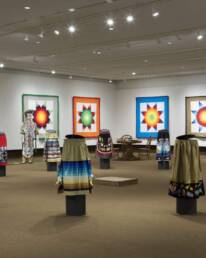
EVENING
ECLECTIC RESTAURANTS
EXPLORE THUNDER BAY’S DINING DELIGHTS
We would be remiss not to note Thunder Bay’s burgeoning and increasingly eclectic restaurant scene. To name just a few hot spots, there’s Tomlin’s seasonal share plates, Bight’s Canadian fare (with a lakefront setting), Kangas Sauna, specializing in Finnish pancakes (and sauna rentals), Red Lion Smokehouse (think: pulled pork) and The Growing Season Juice Collective (cheery and health-conscious).
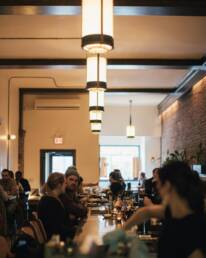
MAGNUS THEATRE
NORTHWESTERN ONTARIO’S ONLY PROFESSIONAL THEATRE
For fifty years the Magnus Theatre has been putting on artfully crafted productions that reflect the company’s vision of being a leader of “innovative and relevant” live theatre and arts education. Intimate, with 250 seats, and historic — the theatre is located in the Port Arthur Central Schoolhouse in Waverly Park — Magnus Theatre is where you can enjoy everything from musicals to ground-breaking contemporary drama, all presented by the only professional theatre company between Winnipeg and Sudbury.
Day Two
MORNING
THUNDER BAY MUSEUM
FROM ONE FORT WILLIAM…
Start the day downtown in the Fort William Business District. (Those needing caffeine may wish to make a stop at Upshot Coffee House, with locally roasted coffee and artisanal pastries.) The south side core was home to the former city of Fort William and is where you’ll find the eye-catching Thunder Bay City Hall, plus the Northwestern Ontario Sports Hall of Fame and Northwestern Ontario Aviation Heritage Centre.
Head to the Thunder Bay Museum, housed in a former police station and courthouse. It’s a good place to explore some of the region’s history through Indigenous artifacts (including intricate Ojibway and Cree beadwork) as well as fur trade relics. You’ll also have the opportunity to learn about Thunder Bay’s industries through the ages, from silver mining to pulp and paper. All that and music too, with a gallery that chronicles Thunder Bay’s musical history from 1870s brass bands to 1970s rock bands.
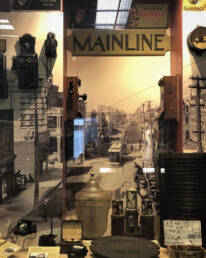
AFTERNOON
FORT WILLIAM HISTORICAL PARK
… TO ANOTHER
A twenty-minute drive takes you from the Fort William district to Fort William Historical Park, a reconstruction of the 1816 fur trade post. It’s one of the largest living history attractions in North America, where period-costumed actors guide your way. Located on 250 acres, with over fifty heritage buildings (as well as a modern visitors’ centre), you’ll get a close up view of fur trade life via culture, crafts, farming, medicine and more. The Anishinaabe encampment (eye-witness accounts from the 1800s note an Indigenous camp east of the fort) and the Voyageurs encampment will give you a sense of the complicated intersection of Metis, Scottish, French Canadian and Ojibwa lives in the region. (Science sidebar: the state-of-the-art David Thompson Astronomical Observatory, located in the park, has one of the largest telescopes in central Canada.)
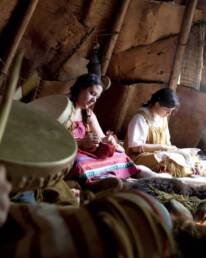
AFTERNOON
ANEMKI WAJIW/MOUNT MCKAY
VISIT THUNDER MOUNTAIN
Located on Fort William First Nation, a twelve-minute drive from Fort William Historical Park, lies Anemki Wajiw (Thunder Mountain), also known as Mount McKay and a site of spiritual significance for Indigenous peoples. As the tallest point in the Nor’Wester mountains, a group of peaks south of the city, the views are magnificent — from the lookout, you can see the city’s south side, Lake Superior, and also Nanabijou (the Sleeping Giant), a series of mesas with a rich history of Indigenous legends associated with their formation. (And yes, you guessed it, it looks like a sleeping giant!) For centuries a place for traditional Indigenous ceremonies, today it’s home to Fort William First Nation pow wows.
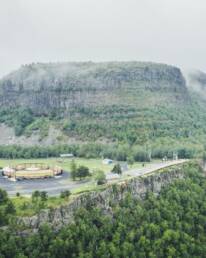
EVENING
THUNDER BAY COMMUNITY AUDITORIUM
DINNER AND A SHOW
Before making your way to the Thunder Bay Community Auditorium to take in a show, head back to the Bay & Algoma area for a good meal. Check out Nook for Italian fare, or Lot 66 for an intimate winebar experience. Or check out some of the options in the Downtown South core like Caribou Restaurant + Winebar’s “North American modern”.
Superior acoustics and a warm, intimate environment make the TBCA a fine concert hall, home to the Thunder Bay Symphony orchestra with its full season of masterworks and pops programs. It’s also the place to catch comedy, dance, pop and rock, and you’ll find all of that on Paul Shaffer Drive, named in honour of Thunder Bay’s own Paul Shaffer of The Late Show With David Letterman fame.
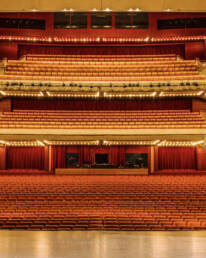
TAKE A DETOUR
THUNDER BAY COUNTRY MARKET
If you’re inspired by Thunder Bay’s Finnish history, make your way to the Thunder Bay Country Market, open Wednesdays and Saturdays. The Finlandia Co-operative has opened up a pop Hoito Restaurant where you can try some Finnish pancakes!
YOUR TRIP AT A GLANCE
SEE
Thunder Bay Art Gallery
The Public Art Walking Tour Guide
Spirit Garden
Ahnisnabae Art Gallery
Wake The Giant Music Festival
Sail Superior at Pier 3
Magnus Theatre
Northwestern Ontario Sports Hall of Fame
Northwestern Ontario Aviation Heritage Centre
Thunder Bay Museum
Fort William Historical Park
David Thompson Astronomical Observatory
Thunder Bay Community Auditorium
Thunder Bay Symphony
The Alexander Henry
YOUR TRIP AT A GLANCE
This guide represents a weekend-long experience, highlighting one of the many wonderful destinations in the area. To suggest a destination for a future guide, please contact us.
All editorial decisions were made at the sole discretion of Ontario Culture Days staff. This guide was written by Li Robbins.
Durham Region North
May 18, 2022 | Photo: Image reproduced with the permission of Ocala Winery & Orchards
Durham Region North
From lake to lake — Scugog to Simcoe — Durham Region North is a rural Ontario destination known for rolling farmlands, charming towns, and the Oak Ridges Moraine, one of the most important formations in Ontario’s greenbelt. All that, plus a vibrant arts and cultural scene.
Day One
MORNINGSCUGOG SHORES MUSEUM
SCUGOG HERITAGE AND HISTORY
Some believe the word “Scugog” comes from the Mississauga “sigaog,” meaning “waves leap over a canoe.” Others, that it’s an Ojibwe word meaning swampy land. Either way, Lake Scugog is at the heart of Scugog Township, and the result of the Scugog River being dammed in 1834. Scugog Shores Museum, located on Scugog Island overlooking Port Perry, is a great way to get a sense of the history. The island is home to the Mississaugas of Scugog Island First Nation, owners of local attraction Great Blue Heron Casino, and hosts of the annual Mississauga First Nation Pow Wow. To explore the cultural history of the Scugog watershed before Europeans arrived, visit the museum’s Ojibway Heritage Interpretive Lands. You can also get a sense of 19th century daily settler life at the Scugog Shores Museum Village.
AFTERNOONPORT PERRY
GALLERY HOPPING IN PORT PERRY
Hard to think of a nicer lakeside spot than Port Perry with its Victorian-era downtown that brims with boutiques, restaurants, galleries and antique shops. (Its charm makes it a frequent film and TV shoot location.) Port Perry is also a base for festive goings on, including Theatre On The Ridge, The Dragon Boat Festival and the award-winning Port Perry Fair. Make time to gallery hop though, since there’s an abundance of possibilities: Meta4 Contemporary Craft Gallery, Croftbeg Studio/Gallery, and Kent Farndale Gallery, among others. Be sure to visit Scugog Arts, a community arts hub featuring cultural events, local art – including the work of artists from Mississaugas of Scugog Island First Nation – and more.

AFTERNOONPALMER PARK
AN AFTERNOON IN THE PARK
Palmer Park is part of Port Perry’s appeal, a scenic waterfront right downtown. Perfect for a picnic, it’s also conveniently close to restaurants and cafés, including the lakeside Boathouse Grill, Piano Inn and Café, and The Pantry Shelf. Water is a theme, with a splash pad for the kids and plenty of folks fishing nearby. (In winter the lake is dotted with ice fishing huts.) Summer Saturday visitors will want to check out the Port Perry Lakefront Farmers’ Market for its local products and artisanal goods. Adjacent Bird’s Eye Park provides tranquil walks with stunning views of the lake.
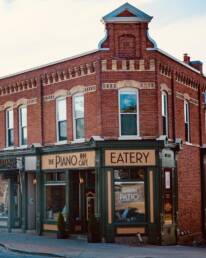
AFTERNOONOCALA WINERY & ORCHARD
VISIT THE VINES
Just a twelve minute drive south west of Port Perry you’ll find Durham Region’s only grape grower, with twenty-five varieties of fruit and six varieties of grapes. Ocala Winery & Orchard dates back to 1912, and you can still enjoy the century-old apple orchard — and maybe a wine tasting too. (If beer’s the thing, drop by local craft brewers, Old Flame Brewing Co. back in town.) Dinner in Port Perry is always a good option. A few popular spots include The Foundry Kitchen & Bar, Pickles and Olives Bistro, and Marwan’s Global Bistro.
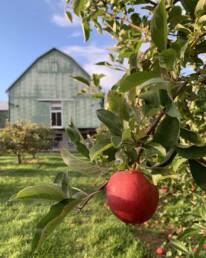
EVENINGTOWN HALL THEATRE
GO TO TOWN (HALL) FOR ENTERTAINMENT
The Town Hall Theatre building has been a Port Perry landmark in the community throughout its century-and-a-half history. And what a history it is: it’s served as municipal town hall, fire station, courthouse, roller skating rink, undergarment factory, movie theatre, and, since the 1970s, a live performance venue. Today it’s a prime spot for award-winning plays and musicals, live jazz, blues and classic rock, comedy, improv, kids shows and more – check the events calendar for more. No wonder it’s considered the centre for performing arts in Durham Region.
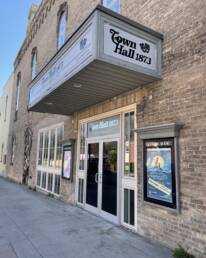
Day Two
MORNINGUXBRIDGE SELF-GUIDED ART TOUR
ART IN THE VALLEY
Uxbridge Township is officially designated “The Trail Capital Of Canada,” given its 220 kilometers of managed trails. But the town of Uxbridge itself, located in an Oak Ridges Moraine valley, is also known for its art and artists, as a self-guided downtown walking tour reveals. Uxbridge also has a strong music history, with one of its earliest industries the Uxbridge Organ Co., established in 1872. Its legacy as a music town lives in in the Music Hall, known for excellent acoustics and beauty, its balcony graced by original opera chairs behind a carved iron railing. Should you need caffeination one favourite is The Bridge Social with its pithy slogan: “Coffee. Trails. Repeat.” Uxbridge is also chockablock with restaurants of all kinds, from tacos to sushi to deli to burgers, making it an ideal lunch stop.
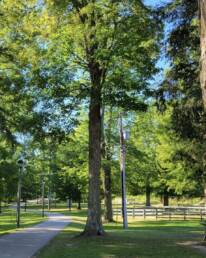
AFTERNOONTHOMAS FOSTER MEMORIAL
THE TAJ MAHAL OF ONTARIO
The Taj Mahal in India, dating back to 1632, was the vision of Mughal Emperor Shah Jahan. The Thomas Foster Memorial, dating back to 1935, was the vision of one-time Uxbridge boy Thomas Foster, who’d visited the Taj Mahal and was inspired to construct his own mausoleum. Foster, who went from working as a butcher’s boy in Toronto to becoming the city’s mayor in 1925, left behind this eye-catching monument, a startling sight on a hilly road in rural Ontario. A beautiful one too, with marble, frescoes, stone pillars and stained glass. During summer months you can hear live music, from folk to jazz.
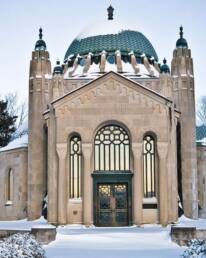
AFTERNOONLEASKDALE MANSE
ANNE OF LEASKDALE
Beloved children’s book author Lucy Maud Montgomery is best known for Anne of Green Gables, set in Prince Edward Island. But she wrote 11 of her 22 published novels in Leaskdale (just north of Uxbridge) from 1911 to1926, where she lived with her minister husband and her sons. Today her husband’s church, St. Paul’s Presbyterian, is a museum filled with L.M. Montgomery memorabilia and the manse has been restored to reflect what it was like in the famous “Anne-with-an-e” author’s time. If you want to explore the area a little further, try driving the Leaskdale Loop, a 20 kilometre cornucopia of maple syrup, farm fresh vegetables, baked goods and local honey.
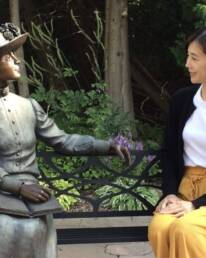
AFTERNOONSUNDERLAND, CANNINGTON, BEAVERTON
THE VILLAGES OF BROCK
Durham Region’s northernmost township is Brock, bordered by Lake Simcoe on the west and home to three distinct villages. Why not visit each one as you make your way to the shores of Lake Simcoe. Sunderland, in the midst of farmland, is home to the historic Sunderland Town Hall (1871), the hundred-plus years fall fair, and the popular Maple Syrup Festival. Cannington has both the charm of Victorian era architecture and the practicality of being a great jumping off point for hikers. Finally it’s Beaverton, where the Beaver River and Lake Simcoe meet. Cottagers and day trippers alike enjoy Beaverton’s harbour by summer, and winter months bring avid ice-fishers to its shores. Have a peek at The Old Stone Church, a modest yet striking building from the mid-nineteenth century, and one of the few original stone churches in Canada.
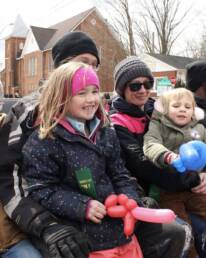
EVENINGBEAVERTON TOWN HALL PLAYERS
LET THEM ENTERTAIN YOU
Local theatre with a heartfelt motto: “Let Us Entertain You,” The Beaverton Town Hall Players put on concerts, musicals, comedies and dramas in the restored 1910 town hall-turned-performance space (check for dates and times before visiting). Boasting a friendly, intimate atmosphere, the theatre group’s mix of professional and amateur players has delighted audiences for the past three decades.
YOUR TRIP AT A GLANCE
HISTORY & CULTURE
Annual Mississauga First Nation Pow Wow
Bird’s Eye Park
The Dragon Boat Festival
Great Blue Heron Casino
Ocala Winery & Orchard
Ojibway Heritage Interpretive Lands
The Old Stone Church
Port Perry Fair
Port Perry Lakefront Farmers’ Market
Scugog Shores Museum
Scugog Shores Museum Village
The Thomas Foster Memorial
NEED A MAP?
This guide represents a weekend-long experience, highlighting one of the many wonderful destinations in the area. To suggest a destination for a future guide, please contact us.
Ontario Culture Days thanks its tourism partners Durham Region for their support and assistance with this article. All editorial decisions were made at the sole discretion of Ontario Culture Days staff. This guide was written by Li Robbins.
Durham Region South
April 29, 2022 | Photo: Pickering Marina. Credit: Captured by Sage
Durham Region South
Durham Region South is conveniently located a stone’s throw from Toronto and offers day-tripping possibilities galore. The region hugs Lake Ontario from Bowmanville to Pickering, making it easy to skip from location to location — and savour lakeside vistas. The lake and the land have held significance for centuries, as the Mississaugas, a branch of the Ojibwa Nation, moved into region circa 1700.
Day One
MORNINGVISUAL ARTS CENTRE OF CLARINGTON
SMALL TOWN CHARM IN BOWMANVILLE
Known for both its art exhibitions and unique location, the Visual Arts Centre of Clarington is in a 19th century barley mill on the banks of Soper Creek. It features both local and national contemporary visual art (and a glorious loft space with original wooden beams soaring overhead). It’s also an education centre, hosting artist talks aimed at making art an interactive exchange of ideas. Regular visitors, get your hands wet! Painting and pottery classes are on offer.
Bowmanville is a charmer with its walkable historic downtown, classic Canadian main street, and grand Victorian mansions. Caffeinate at Roam Coffee or The Toasted Walnut (the latter also serves up homemade meals) or shop at Market By Dream Day (“your one-stop shop for everything local.”) Once the sun is over the yard arm consider a visit to local craft brewery, Chronicle Brewing.

MORNINGTYRONE MILLS
POWERED BY WATER (AND APPLE CIDER)
Alternatively, spend the first half of the day out at Tyrone Mills. For over 170 years Tyrone Mills (a thirteen minute drive north of Bowmanville) has served as a grist, flour and lumber mill. Today, it still uses water power for lumber manufacturing and flour production. Take a tour of the mill or sample local wares and baked goods (apple cider donuts, anyone?). Speaking of apples, en route to the mill drop by Archibald’s Estate Winery, specializing in apple wine recipes. Discover the many temptations of apple-based wines, from sweet to dry, in a complimentary tasting.
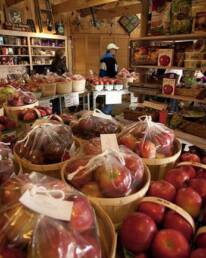
AFTERNOONURBN | MRKT OSHAWA
NOSH IN OSHAWA
Opened in 2021 in a downtown Oshawa landmark, the former RBC building, URBN MRKT has quickly become a favourite spot, with tasty snacks ranging from Korean barbeque to classic Quebec poutine. It’s the place to shop for farm-fresh local produce and artisanal products — more an experience than a stroll through your average grocery store! If a sit-down restaurant’s your thing, downtown Oshawa has plenty on offer, including Street MoMo’s Indian-Asian cuisine or The White Apron’s “comfort classics.”
AFTERNOONOSHAWA MUSEUMS
BOOKEND YOUR DAY WITH ART…
Visit Oshawa’s Robert McLaughlin Gallery, known for the most extensive collection in Canada of the Painters Eleven — Ontario abstract painters who helped popularize the art form. While the gallery’s main focus has historically leaned European-ward, you’ll also find striking work by Indigenous artists. As for the gallery’s name, it’s a tip of the hat to the founder of what became General Motors Canada. (The auto baron’s former residence, The Parkwood Estate, also makes for an interesting visit.) The RMG itself was expanded in 1987 by famed architect Arthur Erickson, who created its dramatic, light-filled lobby.
…OR BOOKEND YOUR DAY WITH HISTORY
Oshawa is sometimes viewed as the eastern anchor of the Greater Toronto Area, and it’s rich with history. For example, the automotive legacy — it’s historically known as Canada’s Motor City, as a visit to the Canadian Automotive Museum demonstrates. You’ll find another significant vehicle display at the Ontario Regiment RCAC Museum, with the largest collection of military vehicles in North America. To learn about the history of Oshawa residents, including the area’s Indigenous past and the history of its Black population (the latter dating back to at least 1850), head for the Oshawa Museum, nestled on the shores of Lake Ontario.

Day Two
MORNINGLYNDE HOUSE MUSEUM
THE OLDEST HOUSE IN DURHAM
Whitby is home to the Lynde House, named for Jabez Lynde, a United Empire Loyalist who served in the war of 1812. During that time his home became an inn, a tavern, and a supply depot where the British and First Nations militia could load up heading to battle. Since then the house has moved twice (with thousands lining the streets to watch) to its current location. In summer, savour Clarissa Lynde’s Heritage Kitchen Garden, with plantings typical of the 1800s — chamomile, calendula, yara, savoury and the like. Or drop into the little brick building next door, the Warren General Store, for gifts, home décor and sweet treats.
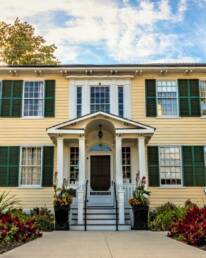
AFTERNOONSTATION GALLERY
ART IN THE GRAND TRUNK RAILWAY STATION
Arts and culture abound in the region, and the Station Gallery has been celebrating that fact since 1967 when passionate arts enthusiasts opened the first community gallery. Next, they bought the local Grand Trunk Railway Station (for a dollar — it was slated for demolition) and made it the gallery’s new home. Today the renovated station features exhibitions by emerging, mid-career and established artists, as well as classes, workshops, performances and special events, making it “a champion of all things empowering and creative.”
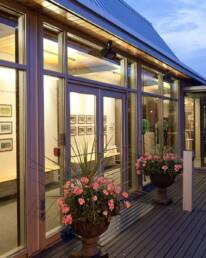
AFTERNOONAJAX
WEND YOUR WAY ALONG THE WATERFRONT TRAIL
Before exploring Ajax’s impressive 400 hectares of open space, parks, playgrounds and conservation areas, consider a lunch stop. Two possibilities: The Portly Piper for classic pub fare, or Maimana Naan & Kabab for its cultural crossroads of Afghani, Indian, Greek and Iranian-inspired cuisine. After that, yes to exercise! No better place than the Waterfront Trail, winding through Ajax’s lovely parks. Along the way, linger at Veteran’s Point Gardens. It’s a contemplative spot where you can absorb the history of Ajax and World War ll, and its intriguing design conjures up the shape of a ship.
AFTERNOONPICKERING NAUTICAL VILLAGE
RELAXING IN THE VILLAGE
Frenchman’s Bay is home to the unique waterfront community of Pickering Nautical Village. Between the beach, the boardwalk, and the boat launch there’s something for everyone. (Including a splash pad, swings and slides for the kids.) Open Studio Art Café has live art (life drawing) and live music (open mics and concerts). Dining choices range from North American bistro fare at Port, with waterfront views, the Mexican-inspired Chúuk, and Zeera By The Bay for traditional Indian food. (Note too that Pickering is home to mouth-watering Caribbean deliciousness, found at Beryl’s Pepper Pot, Roti N’Ting and Yardies Carribean Cuisine, among others.) For afters consider GrandDad’s Old Fashioned Ice Cream Parlour, home to every conceivable flavour of Ontario favourites: Kawartha Dairy, Chapman’s, and Central Smith.
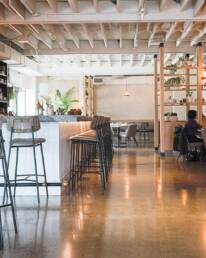
EVENINGST. FRANCIS CENTRE; HERONGATE BARN THEATRE
BE ENTERTAINED IN A FORMER CHURCH…OR BARN
Have a look at what’s on at St. Francis Centre for Community, Arts & Culture or the Herongate Barn Theatre. St. Francis, built in 1871, is an excellent example of High Victorian Gothic church architecture. It’s also an excellent example of a state-of-the-art performance space for music, theatre and comedy. A fifteen-minute drive away you’ll find another unique entertainment setting: Herongate Barn Theatre, housed in a century-old dairy farm. Dine in a former bull pen or hay manger then head up to the renovated loft for laughs or gasps — the Herongate specializes in staged comedies and mysteries. Check the event calendars to keep up with the wide variety of events at these venues.
YOUR TRIP AT A GLANCE
YOUR TRIP AT A GLANCE
This guide represents a weekend-long experience, highlighting one of the many wonderful destinations in the area. To suggest a destination for a future guide, please contact us.
Ontario Culture Days thanks its tourism partners Durham Region for their support and assistance with this article. All editorial decisions were made at the sole discretion of Ontario Culture Days staff. This guide was written by Li Robbins.
Cobalt and Temiskaming Shores
February 28, 2022 | Photo by Sue Nielsen
Cobalt and Temiskaming Shores
Rocky Canadian shield, vast lakes, majestic forests — welcome to Ontario’s north. Indigenous peoples have inhabited these lands for centuries and Lake Temiskaming, at the headwaters of the Ottawa River, makes it an historic region for transportation and trade. Then there’s the extraordinary history of Cobalt’s silver rush in 1903, resulting in headlines around the world. No wonder the region provided inspiration for artists like the Group of Seven.
Day One
MORNINGCOBALT SILVER HERITAGE TRAIL
THE SILVER BOOM THAT SURPRISED THE WORLD
The stampede for glittering silver turned Cobalt into the fourth-largest silver producer in history, with Willet G. Miller, Ontario’s first provincial geologist, noting there were “pieces of native silver as big as stove lids and cannon balls.” In truth, for two thousand years before white man’s ‘discovery’ of silver, Indigenous people had been trading metals from the area — ceremonial panpipes and jewellery made from Cobalt silver has turned up in burial mounds and archeological digs across North America. This did not deter white prospectors and claim jumpers though. They swelled the town’s population, and the frenetic growth included everything from saloons to an opera house. The speed at which Cobalt was born is evidenced today in the curving streets and wood-framed houses perched precipitously on hills. It’s a bit of a time machine, with the old mining buildings best explored via the self-guided Cobalt Silver Heritage Trail. For a look through an arts lens, visit Lake Temiskaming Tours.
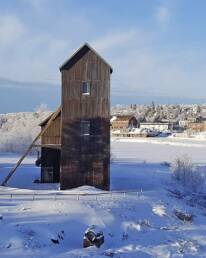
AFTERNOONTHE COBALT MINING MUSEUM
A TREASURE TROVE OF SILVER STORIES
Take a lunch break at the Silver Café, an unpretentious spot with good diner fare. Or nab fresh baked goods at the wittily-named Fresh AF Market & Eatery. It’s a farm-to-market grocers, hence the name: Fresh (A)s (F)arm Market. Then head to the Cobalt Mining Museum, a literal treasure trove with the world’s largest display of native silver ore, plus a deep-dive collection of silver rush artifacts. At its mining peak Cobalt had over 100 mines, and it’s credited with creating the Toronto Standard Stock and Mining Exchange in 1908. As the joke of the day went, Toronto was the place you changed trains to get to Cobalt! No wonder Cobalt’s been called Ontario’s Most Historic Town and is a Parks Canada National Historic Site.
AFTERNOONWHITE MOUNTAIN TO THUNDER / DEVIL‘S ROCK
A LITTLE BROWSING, A LITTLE HIKING
White Mountain Books provides excellent browsing as well as the opportunity to learn more about local history. The bookstore is even housed in an historic site, the Coniagas Shaft House #4 at Silver Street and Prospect Avenue. Check out Poor Boy Soles Bespoke Shoe Co. for made-to-measure footwear and leather goods using traditional techniques. Then visit Laura’s Art Shoppe for locally-made sculpture, pottery and glass creations, as well as cards and prints reflecting Temiskaming’s beauty. From shopping to hiking — a fifteen-minute drive east takes you to the magnificent cliff originally known as Manidoo-Wabikong, today as Thunder / Devil’s Rock. The 40-minute hike (two to four kilometres, depending on the trail) ends with superb views of Lake Temiskaming. Thunder / Devil’s Rock has literary history too, featured on the cover of the Hardy Boys mystery, The House on the Cliff, ghost written by local (and highly successful) author Leslie McFarlane.
EVENINGPUB OR TAVERNE TIME
DELICIOUS DINING, CRAFT BEER AND LIVE MUSIC
Just north of Cobalt is Temiskaming Shores, the amalgamation of the towns of New Liskeard and Haileybury and the township of Dymond. (You may want to motel it in either Haileybury or New Liskeard — a ten minute drive apart. The latter’s Waterfront Inn has terrific lake views.) For a pub stop in Cobalt the place to go is Miner’s Tavern, boasting live local music. Or check out the Classic Theatre, the only remaining theatre from the silver boom, with shows ranging from theatre and music to comedy. Heading straight to Haileybury? Consider dining at L’Autochtone Americaine Taverne, with its “contemporary take on North American classics as seen through an Indigenous lens.” Makes sense, given the area is home to three cultures: Indigenous, Quebecois and English. Coffee hounds note: L’Autochtone Americaine also runs Busters Mini-Mart, a hybrid café-specialty food store. As for craft beer fans, your destination is Haileybury’s The Whiskey Jack Beer Company.
Day Two
MORNINGWANDER HAILEYBURY
THE HOME OF MILLIONAIRE’S ROW
Haileybury was founded in 1889 by Charles C. Farr, an employee of Hudson Bay Company. As a lakeside neighbour to Cobalt, many mining bigwigs made it their home, evidenced by beautiful houses from that era that still exist on Lakeshore Road, once known as Millionaire’s Row. Walking in downtown Haileybury and out to the marina is a great way to see the town and its lovely sand beach, complete with waterslide.
MORNINGHAILEYBURY HERITAGE MUSEUM / TEMISKAMING ART GALLERY
HISTORY AND HERITAGE IN HAILEYBURY
Drop into the Haileybury Heritage Museum to explore the town’s history, in particular the 1922 fire (one of the ten worst natural disasters in Canadian history). It’s an essential stop for Northern Ontario history buffs and kids alike. The latter will beeline to the fire truck, streetcar and tugboat on display. The former will be intrigued to know that, after the fire, Toronto sent a fleet of streetcars… for relief housing. Next, head to the Temiskaming Art Gallery, a showcase for both local artists as well other artists from Ontario’s north. The gallery is also home to Open Studio Libre, a free-access art studio
AFTERNOONNEW LISKEARD
A LAKE LUNCH STOP
New Liskeard, the biggest of the three towns making up Temiskaming Shores, is on the northwest tip of Lake Temiskaming, making it a perfect place to savour the vast lake’s beauty. Savour lunch too, with options including Tap That Bar & Kitchen’s “barrel aged cocktails to craft burgers and comfort food” or Ali’s Grill & Bar’s “casual fine dining.” Café and book/game lovers check out Chat Noir Books with its vast collection of books and games, plus specialty coffees. The Riverside Farmers’ Market is a seasonal stop on Saturdays for farm-fresh produce, and local crafts and artwork. Also on the waterfront, take time for reflection at the moving monument to Shannen Koostachin, who led a campaign to have a new school built in her Indigenous community — the largest youth-led rights movement in Canadian history.
AFTERNOONLITTLE CLAYBELT MUSEUM TO BISON DU NORD
COWS, PIONEERS, CHEESE… AND BISON!
North of New Liskeard the land transitions from rugged shield to the flatlands of the clay belt, a surprise to many first-time northern visitors. The giant Ms. Claybelt, a 12-foot tall cow, stands proudly beside The Little Claybelt Homesteaders Museum as a marker of the region’s agricultural prowess. The museum itself looks at early pioneer life from the 1880s to the 1950s. Continue north on highway eleven stopping at farmer-owned, award-winning Thornloe Cheese (20 minutes), and Bison du Nord (30 minutes). Bison du Nord is the largest bison farm in Eastern Canada, with educational tours letting you get up close to the shaggy beasts.
EVENINGEVENING IN NEW LISKEARD
WINING, DINING, AND WALKING
A popular spot for dinner is 28 On The Lake for high-end pub food and a great view of Lake Temiskaming. Or check out Zante’s Bar & Grill, with farm-to-table cuisine. Take a post-dinner stroll along the lovely waterfront boardwalk trail before enjoying live music at either of the above (Zante’s is also home to trivia nights). Note to Francophiles: check out Le Centre culturel ARTEM for everything from Francophone bingo to singing barbers.
YOUR TRIP AT A GLANCE
SEE
COBALT SILVER HERITAGE TRAIL
LAKE TEMISKAMING TOURS
COBALT MINING MUSEUM
THE CLASSIC THEATRE COBALT
MANIDOO-WABIKONG, KNOWN TODAY AS THUNDER/DEVIL’S ROCK
HAILEYBURY HERITAGE MUSEUM
TEMISKAMING ART GALLERY
MS. CLAYBELT
THE LITTLE CLAYBELT HOMESTEADERS MUSEUM
BISON DU NORD
LE CENTRE CULTUREL ARTEM
MONUMENT TO SHANNEN KOOSTACHIN
NEED A MAP?
This guide represents a weekend-long experience, highlighting one of the many wonderful destinations in the area. To suggest a destination for a future guide, please contact us.
All editorial decisions were made at the sole discretion of Ontario Culture Days staff. This guide was written by Li Robbins.
Peterborough
Photo courtesy of Destination Ontario.
Peterborough
Peterborough is built on the shores of the Otonabee River, first known as Nogojiwanong, which is Ojibwa for “place at the end of rapids.” The Otonabee (or Odenabe, “river that beats like a heart”) isn’t the only waterway to criss-cross the city: a canal (part of the Trent-Severn Waterway) and a creek (Jackson) also run through it. So, Peterborough’s culture is intrinsically linked to this unique and striking setting.
Day One
MORNINGTHE CANADIAN CANOE MUSEUM
A CANOE ON EVERY CORNER
You know you’re in Peterborough when you spot a canoe on practically every corner. Some are land-bound, like the art installation Jiimaan’ndewemgadnong — The Place Where the Heart of the Canoe Beats, at the corner of King and Water Streets, by Anishinaabe artist Tia Cavanagh.
But there’s no better place to understand the canoe’s significance than the Canadian Canoe Museum. It’s the world’s largest collection of paddled crafts, filled with stunning, historic canoes and kayaks. The collection spans from the First Nations of the Pacific Northwest’s huge dugouts to bark canoes of Newfoundland’s Beothuk. In 2023 the museum is poised to expand in a new location and building on the water, with more exhibits to reflect its collaborative relationships between Indigenous and non-Indigenous peoples.
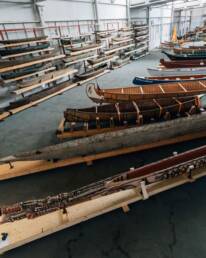
AFTERNOONHUNTER STREET CAFÉ DISTRICT
THE CAFÉ LIFE, PETERBOROUGH STYLE
Peterborough is a smallish city, with a population of 84,000 and change. But it boasts a vibrant café district along Hunter Street West. A couple of attractive blocks of bars, cafés and boutiques, it includes The Only Café, perched on the edge of Jackson Creek. The Only is an institution known for excellent sandwiches, eclectic décor, and as a favourite hang for everyone from students to politicians. Another long-running favourite is Black Honey Bakery — a homey, cozy café with tasty brunches and vegan options. On the shopping front, head to Hunter and George Streets for hip fashions (S.O.S.), locally-branded “Ptbo Northern Originals” wear (Flavour), or handcrafted jewelry and gifts (Hi Ho Silver).
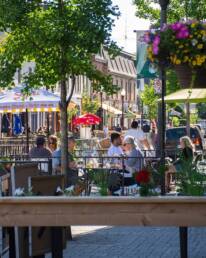
AFTERNOONHUTCHISON HOUSE
SEE HOW THE SETTLERS LIVED
Step back in time at Hutchison House, a short walk from Hunter Street. Locals built the home in 1837 to entice Peterborough’s first resident physician, Dr. John Hutchison, to stick around – they were successful. Now it sits filled with medical instruments, books and furnishings of the time. The museum also has memorabilia belonging to the good doctor’s cousin, Sir Sandford Fleming, famed engineer, scientist and inventor. Fleming’s design for a forerunner of the roller blade is one of the many charming artifacts on display. In summer, take tea on the terrace; in winter, sip beside the open hearth in the Hutchison House kitchen.
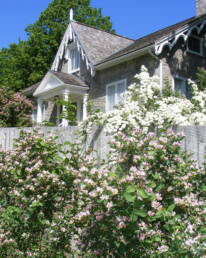
AFTERNOONLIFT LOCK
THE WORLD’S TALLEST BOAT LIFTER
A marvel of engineering, the Lift Lock its the highest hydraulic lift lock in the world and is designed to lift boats nearly twenty metres. The Lift Lock Visitor Centre explains how that’s done, as well as answers all your Trent-Severn Waterway questions (the 386-kilometre-long canal that connects Lake Ontario to Georgian Bay).
Want to get inside the Lift Lock? A Lift Lock Riverboat cruise gives you a boat’s-eye-view. Or, for the jaw-dropping experience, bring your own kayak or canoe to join in on the annual Lock ‘n’ Paddle.
In winter, skate the canal beneath the mighty lock. In summer, picnic on canal banks.
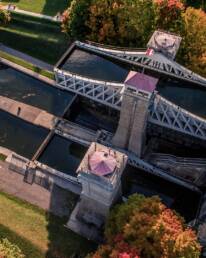
AFTERNOONART GALLERY OF PETERBOROUGH
CONTEMPORARY ART ON THE (LITTLE) LAKE
Located south of downtown on Little Lake, the AGP is a little gem of contemporary art. Its permanent collection includes work by significant regional Indigenous artists (Mary Anne Barkhouse, Michael Belmore), as well as artists from further afield (Daphne Odjig, Carl Beam, Jane Ash Poitras, and Rebecca Belmore). While you’re there, drop into the Gallery Shop for regional one-of-a-kind arts and crafts, and fun stuff for kids too. For a restful summer afternoon stop, don’t miss ice cream by the river at the cottage-like Silver Bean, just a 10-minute walk north of the gallery.
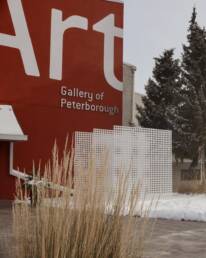
EVENINGCULINARY PETERBOROUGH
WINE, DINE, AND STROLL THE OTONABEE
Excellence and diversity are markers of the city’s culinary strengths, for instance La Hacienda’s Mexican cuisine (and adjacent mercado), Hanoi House’s Vietnamese food (and oysters) and Fresh Dreams (traditional Spanish Tapas). All are located in and around Hunter Street West, not far from the beautifully landscaped Millennium Park trail. A post-dinner easy stroll along the Otonabee includes sculptures and a display tracing the city’s Indigenous and colonization history.

EVENINGLIVE MUSIC
FROM THE BLACK HORSE TO THE RED DOG — CATCH SOME TUNES
Peterborough is a music-loving town, and two venerable establishments are The Black Horse (jazz and blues) and the Historic Red Dog Tavern (reggae, rock, and hip hop). Yes, “historic” is part of the official name, opening as a hotel in 1883, and going on to become known as “the home of live music.” Many a legendary musician (Neil Young, Ronnie Hawkins, Jeff Healey) have played the Red Dog, a tradition continuing today with both nationally-known and rising-star local acts.
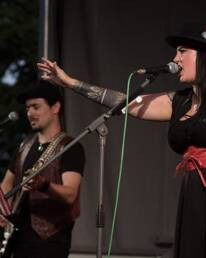
Day Two
MORNINGNOGOJIWANONG TO PETERBOROUGH (AND BACK AGAIN)
AUTHENTIC CONNECTION TO LAND, WATER AND PEOPLE
Peterborough is known by many names: The ‘Boro, The Patch, Ptbo, Electric City, and increasingly by its original Ojibwe name, Nogojiwanong. For a deeper understanding of this Indigenous culture, take the 30-minute drive north to Curve Lake First Nation. Along your way, enjoy the scenic river views for most of your drive.
There you’ll find both the Whetung Ojibwa Centre and Curve Lake Cultural Centre. The Curve Lake Cultural Centre is dedicated to keeping traditions and ceremonies alive within the community. Immerse yourself in the history and culture of the people, the Michi Saagiig Anishnaabeg, and learn about their language, geography, history, and traditions.
Two minutes down the same road, the Whetung Ojibwa Centre offers a spectacular collection of Native crafts and fine art from both Curve Lake First Nation and across Canada. In addition to the shop, there is also a museum with totem poles, headdresses, moccasins, dreamcatchers and more, all within a 10,000 sq ft building. This centre is open seven days a week, and if you are in the area at the end of summer, you are welcome to attend the annual Pow Wow.
AFTERNOONLAKEFIELD
TAKE THE SCENIC RIVER ROAD TO LAKEFIELD
Peterborough has enviable proximity to lovely lakes and charming towns. Lakefield combines both, just south of Katchewanooka Lake and right on the Otonabee. A twenty-minute drive along the winding Water Street from downtown brings you past Trent University and into picturesque Lakefield. The town’s literary history (authors Susanna Moodie, Catherine Parr Traill, and Margaret Lawrence all made their homes there) makes it the logical place for July’s annual Lakefield Literary Festival. (Resuming in 2023.) Shop Queen St., or make it your dinner stop. A few popular spots: Canoe & Paddle pub, Cassis Bistro (fine dining), and The Nutty Bean, boasting “the best verandah” in town.
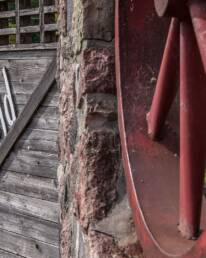
AFTERNOONPETERBOROUGH MUSEUM AND ARCHIVES
TAKE THE SCENIC RIVER ROAD TO LAKEFIELD
Finally reaching the north end of Peterborough on your drive back in, you’ll find the family-friendly Peterborough Museum and Archives tells the local story. From early Indigenous communities and the first wave of Irish immigration, and the city’s rise and fall as an industrial town and beyond, their collection speaks of it all.
For an early dinner, wander around the East City. One choice spot: Ashburnham Ale House for local beers and high-end pub grub.
AFTERNOONJACKSON PARK
FOREST IN THE CITY — A CULTURAL HERITAGE LANDSCAPE
Jackson Park is one of a handful of Ontario parks with old-growth forest, and also a recently designated cultural heritage landscape. Yet it’s only a five-minute drive from Hutchison House. Stroll around the pond, a favourite spot for waterfowl and those wishing to photograph them. Pause on the restored, 1894 pagoda bridge. Or enjoy the 4.2 kilometre Jackson Creek trail, its rushing waters your soundtrack for walking, biking, or cross country skiing — Peterborough Nordic Club maintains classic ski tracks. Omemee (songwriter Neil Young’s hometown) is also a favourite cycling destination, the 44 kilometre round trip taking you over Doube’s Trestle Bridge with spectacular views of Buttermilk Valley.
EVENINGMARKET HALL PERFORMING ARTS CENTRE
TO MARKET FOR MUSIC, OR THEATRE, OR DANCE
Located beneath Peterborough’s landmark clock tower, Market Hall is known for its theatrical and musical presentations, though it’s also a vibrant community centre, featuring political debates and more. Spacious yet still intimate, it’s come a long way since its 19th century days as a food market. Enjoy a show while testing out the local theory: the beautifully restored Market Hall hasn’t got a bad seat in the house.
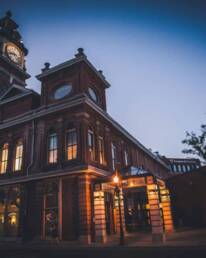
WANT TO TAKE A DETOUR?
WARSAW CAVES CONSERVATION AREA
The Warsaw Caves Conservation Area (a twenty-minute drive from Lakefield) will satisfy almost any outdoor itch you want to scratch, with scenic hiking trails, camping, and paddling, fishing or swimming on the Indian River. You can even go spelunking in the seven namesake caves, which were formed at the end of the last ice age.
YOUR TRIP AT A GLANCE
SEE
Art Gallery of Peterborough
Art Space
The Canadian Canoe Museum
Hutchison House
Jackson Creek trail
Lakefield Literary Festival
Lift Lock Visitor Centre
Market Hall Performing Arts Centre
Peterborough Museum and Archives
Showplace Performance Centre
Trent University
Warsaw Caves Conservation Area
Whetung Gallery
NEED A MAP?
This guide represents a weekend-long experience, highlighting one of the many wonderful destinations in the area. To suggest a destination for a future guide, please contact us.
All editorial decisions were made at the sole discretion of Ontario Culture Days staff. This guide was written by Li Robbins.
Ottawa – Local
Updated November 2022 | Photo credit: © Destination Ontario
Ottawa – Local
The nation’s capital is known for its impressive “big-ticket” possibilities: Parliament Hill, international festivals, nationally significant museums, and the world’s longest skating rink and largest Tulip Festival. But for millennia before French explorers arrived, Indigenous Peoples were living and trading in the region. Their history is everywhere, emerging more each day, and you can hear it in the language: the Algonquins called the region “Odawa”, where Ottawa’s name comes from, meaning “traders.” So, beyond those big-ticket possibilities, visit for a rich cultural experience, a palette of diverse cuisine, and creativity from all corners of the nation’s capital.
Day One
MORNINGTWO FARMS, TWO WAYS: THE EXPERIMENTAL FARM AND MĀDAHÒKÌ FARMS
INDIGENOUS PERSPECTIVES, INDUSTRY AND SPIRIT HORSES
Mādahòkì Farm builds on the growing interest in agritourism in Ottawa’s Greenbelt, including farm-to-table culinary experiences and authentic cultural experiences from an Indigenous perspective. The Farm hosts a series of Indigenous events celebrating the seasons: Sīgwan (Spring), Tagwàgi (Autumn) and Pibòn (Winter) and the annual Summer Solstice Indigenous Festival. Year-round, the Farm is also the home of an Indigenous Marketplace and five endangered Ojibwe Spirit Horses.
A WALK ON A WORKING FARM… IN THE CITY
In our changing industrial world, farms and cities are trying to strike a new balance with each other. The Central Experimental Farm is a few kilometres from downtown. But it’s no hobby farm, not at 426 hectares. Established in 1886, the farm has made significant contributions to Canadian agriculture, like developing the world-famous, frost-resistant Marquis wheat. When you visit, deep dive into our nation’s agricultural heritage at the Canadian Agricultural and Food Museum. Or, just talk to the animals: the museum is home to cows, alpacas, pigs, horses, goats and more.
At the Experimental Farm, wend your way along winding paths reminiscent of a British country estate: swathes of lawn, ornamental gardens, an arboretum with some trees planted back in 1889. Along the path, catch the distinctly Canadian sight of the Rideau Canal and Dow’s Lake. An Experimental Farm visit is a unique experience, literally: it’s the world’s only working farm in the heart of a capital city.
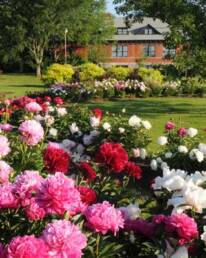
AFTERNOONHAPPENING HINTONBURG
QUIRKY AND CUTE: WELLINGTON WEST’S HINTONBURG
Bustling, artsy, trendy, eclectic, cool: just some of the descriptors of Wellington West, on your drive back in from the farms. East of Holland Avenue, it’s Hintonburg, with great specialty stores — a far cry from the rail yards, lumber and paper mills of its 19th century days. Same with the neighborhood’s designation as the QUAD (Quartier des artistes/Arts District), as Hintonburg is home to galleries, studios, and art-friendly restaurants.
As to those specialty stores: they are thinking local and sustainable. Terra20 sells cruelty-free, non-toxic and ethically sourced products. At Nu Grocery, Ottawa’s first zero-waste grocery store, you’ll find everything from cereals to toothpaste. Drop by the Maker House Co. for handmade homewares created by Ottawa artisans. Don’t forget music: The Record Centre, purveyors of new and used vinyl (and turntables), has also been known for local band performances.
Need a sip and snack break? Try one of the wonderfully named local chains: the Ministry of Coffee and Social Affairs, or Happy Goat Coffee.
AFTERNOONFASHION AND FOOD
GO WEST TO WELLINGTON VILLAGE
Go west (of Holland Ave.) to Wellington Village for a myriad of possibilities from Canadian independent designers. It’s all about boutiques. Kindred Shop and Studio’s ethically made clothing and made-in-Ottawa gifts; Flock’s handmade, local, sustainable wares; JV Studios & Boutique’s emerging Ottawa brands; Victoire Boutique’s “smitten with Canadian design” approach and more. For a break from shopping, head to the NAK Gallery, opened in 2020 to showcase contemporary visual art.
The Village is also a great spot for a leisurely dinner, with its nearly two dozen restaurants. Just a few possibilities include contemporary Canadian cuisine at Stofa; locally sourced fare at Supply and Demand; or upscale pub food at Wellington Gastropub. (Locals call it The Wellie.) Speaking of pubs, Ottawa craft beer is a growing concern. If it’s of concern to you, consider a Brew Donkey “curated regional adult field trip” to local breweries.
For a quick bite, try Beandigen Cafe, an Anishinaabe owned and operated cafe on the unceded territory of the Algonquin Anishinaabe. Located in the heart of the city at Ottawa’s Lansdowne Park, the café offers coffee, espresso, and light snacks as well as retail space to connect and purchase Indigenous goods, art and crafts from local Indigenous artists. Beandigen is a play on words from the term “welcome” in Anishinaabemowin (Ojibway), which inspired the name and feel of the cafe.”

EVENINGTAKE IN A SHOW
IT’S GREAT, IT’S CANADIAN, IT’S THEATRE
The Great Canadian Theatre Company, or GCTC, as Ottawans call it, is located almost in the centre of Wellington West. It’s also at the centre of the local theatre scene. The city’s largest professional, independent theatre was born in 1975 when Carleton University profs and grad students decided to produce Canadian plays. After two decades of treading the boards in a renovated truck garage the GCTC moved to Wellington West. Now they showcase plays and theatre events at the Irving Greenberg Theatre Centre, with its 262-seat mainstage space. Bonus: Spacious lobbies and a studio theatre make GCTC a hub for community events.
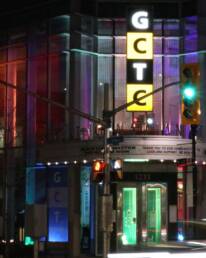
Day Two
MORNINGA NEIGHBOURHOOD WANDER
STROLL THE STREETS OF HISTORIC SANDY HILL
The sandy soil of this slightly-off-the-beaten-track residential neighborhood means you won’t see many tall buildings. But you will see dignified embassies and gracious apartment buildings (circa 1860 to the 1920s). Two of Canada’s most important prime ministers (Sir Wilfrid Laurier and the Rt. Hon. William Lyon Mackenzie King) lived in Sandy Hill. At some times of year you can visit their former home of Laurier House, a Second Empire mansion. Today, Sandy Hill is where affluence meets student living, with bars, brewpubs and coffee shops around the U. of O. Students, locals and tourists alike can enjoy cuisine from around the world, including India, Thailand, Mexico, Japan and Middle East. For a river walk, stroll Strathcona park along the Rideau, where in summertime you can enjoy theatre under the stars.
AFTERNOONSAW GALLERY
VISIT ONE OF CANADA’S LEADING ARTIST-RUN CENTRES
Stop at the SAW Gallery on your way to the market. The artist-run centre is famed for politically and socially engaged artwork and performances. Lured by the North? Check out SAW’s recently opened Nordic Lab with the Annie Pootoogook Studio, named for the celebrated Inuit artist. Take in a community event (from screenings to concerts to artist talks) at Club SAW, complete with bar and state-of-the-art sound system.

AFTERNOONGO TO MARKET
MAKE BYWARD MARKET YOUR ART WALK
ByWard Market is just a stone’s throw from SAW and a perfect place for a café lunch. Pick from a variety of cuisines, including Island Flava, Island Grill, Ocho Rios Caribbean Eatery, Sweetgrass Aboriginal Bistro. And, of course, for the sweet stuff, a.k.a. Beavertails. (Deep fried pastry and sugar. Say no more.) Lieutenant-Colonel John By drained a cedar bog and made a market here in 1827 so the families of workers building the Rideau Canal had a place to shop. Almost two centuries later the market still draws locals for great foodstuffs.
But it’s also a cultural draw. Follow the ByWard Market Art Walk map for stunning murals. The Art Walk includes murals by diverse artists, including Black and Indigenous muralists. Then drop by the Ottawa School of Art for contemporary art exhibits and to browse the boutique for paintings, jewelry and sculpture. All of it Canadian; much of it local.
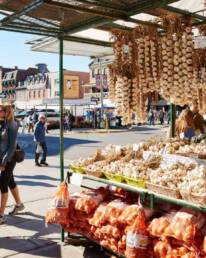
EVENINGBYWARD BY NIGHT
THE MARKET BY NIGHT: DRINKS, DINNER AND BEATS
There’s no shortage of nightlife in the market. Try the storied Chateau Lafayette, a.k.a. The Laff, Ottawa’s oldest tavern since 1849. Or go upscale with Copper Spirits and Sights Rooftop Lounge, for Canadian-inspired cuisine and craft cocktails. (It’s a great sunset spot with a prime view of Parliament Hill.) For late nights drop by the Mercury Lounge, the “twenty-first century soul club” where beats-meets-jazz. Come for drag shows, or to enjoy soca, rap, and rock music. The intimate Mercury has brought music, poetry readings and dance performances to Ottawans for over twenty years.
YOUR TRIP AT A GLANCE
YOUR TRIP AT A GLANCE
This guide represents a weekend-long experience, highlighting one of the many wonderful destinations in the area. To suggest a destination for a future guide, please contact us.
All editorial decisions were made at the sole discretion of Ontario Culture Days staff. This guide was written by Li Robbins.


